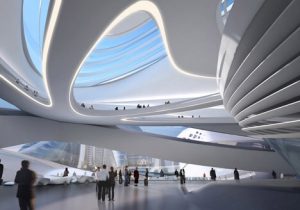
The field of architecture has been developing a new type of design strategy in the past few decades. Based on conventional modern space designs, some architects are passionate about so-called “parametric design,” which is a style of architectural design that is generated through the use of algorithms and computer programming. One of the most well-known pioneers of this field is the principal of Zaha Hadid Architects Patrik Schumacher. Schumacher spearheaded this concept called “parametricism.” This type of design methodologies are highly computer-based, employing 3D modeling softwares like Rhino and Revit, as well as scripting platforms like Grasshopper and GH Python. Generative modeling enables complex forms and structures to be created through scripts easily, which is almost impossible to model by hand. However, the fabrication methods are not caught up with the parametric designs that architects theorize today. Fabrication of parametric architecture requires an extraordinary amount of money and time. In fact, the original design of the 2020 main stadium of the Olympics in Tokyo, designed by Zaha Hadid, was renounced because of the difficulties in terms of the budget.

Though still encountering a lot of difficulties in the reality, parametric architecture is a theory that will dominate the architecture industry sooner or later. As architecture majors, we heavily focus on modern world software society, and we take generative modeling courses that teach grasshopper and gh python. Getting more familiar with parametric architecture, I am looking forward to capturing more of the yet abstract concepts and theories about algorithms in the field of art and architecture.
![[OLD FALL 2018] 15-104 • Introduction to Computing for Creative Practice](wp-content/uploads/2020/08/stop-banner.png)